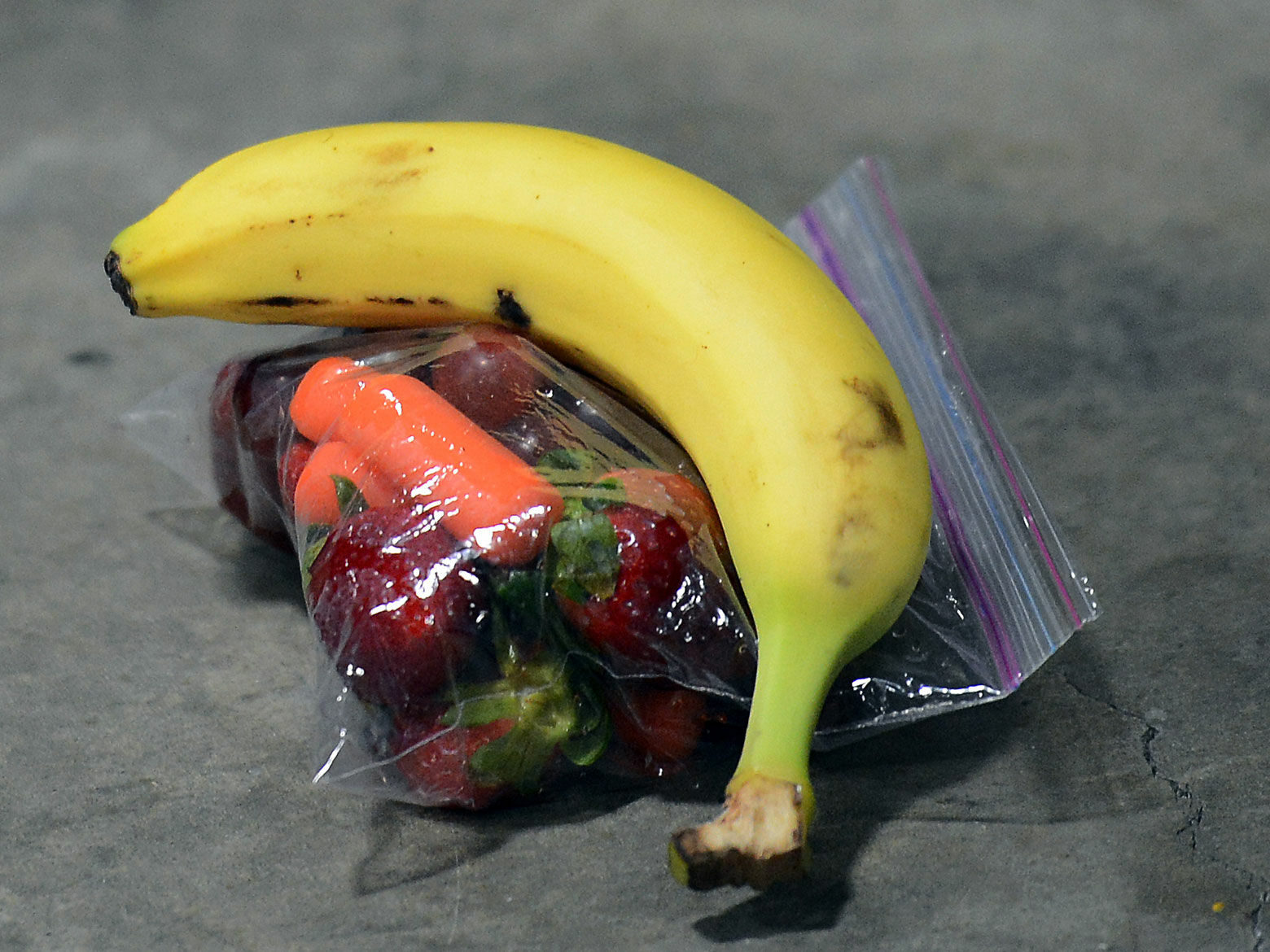Meal planning and more: Nutrition tips to get virtual school year off to a healthy start
 1/10
1/10
Limit how much junk food you have in the house and pack healthy snacks in the fridge the night before.
(Toni L. Sandys/The Washington Post via Getty Images)
Break bad habits with the start of the new school year
Use the new school year as an opportunity to hit the reset button on any unhealthy habits you may have fallen into over the last few months, Mohning said. And one way to do this is to limit how much “junk” food you have in the house. In addition to that, aim to get healthy foods into your stomach first.
“We want to keep our immune systems strong,” she said. “We want to make sure we’re getting the fruits and vegetables. As long as we get those basics in, there’s always an opportunity to have a treat or a dessert that a child wants.”
Mohning suggested packing “bento box” style meal kits in the fridge for kids to grab when it’s lunchtime. That way it takes away the anxiety of managing a meal for a hungry child in the middle of a busy workday.
![<p><strong>Make a menu for the week or the month</strong></p>
<p>Map out and schedule meals ahead of time, Mohning said. Consider talking with your children about what their favorite proteins and vegetables are, so you can make a menu for the week or the month. That way, not only can you make sure your grocery trips are more efficient or your Instacart orders don’t have missing items, but you can also plan meals that everyone in your home will enjoy.</p>
<p>She said if your family knows that dinner is at 6:30 p.m., they will be less likely to hunt for a snack at 5 p.m.</p>
<p>Shapiro said her clients even looked at old school lunch menus for inspiration.</p>
<p><span style="font-weight: 400;">“They brought some of those [favorite meals] back because they hadn’t had them for so long.”</span></p>](https://wtop.com/wp-content/uploads/2020/08/GettyImages-1190566033_meal_calendar.jpg) 2/10
2/10
Anne Lee swaps around her planned recipes because she is missing an ingredient while she plans her family’s dinner for that night at the Lee family’s dairy farm in Berkshire, New York, on Dec. 4, 2019.
(Carolyn Van Houten/The Washington Post via Getty Images)
Make a menu for the week or the month
Map out and schedule meals ahead of time, Mohning said. Consider talking with your children about what their favorite proteins and vegetables are, so you can make a menu for the week or the month. That way, not only can you make sure your grocery trips are more efficient or your Instacart orders don’t have missing items, but you can also plan meals that everyone in your home will enjoy.
She said if your family knows that dinner is at 6:30 p.m., they will be less likely to hunt for a snack at 5 p.m.
Shapiro said her clients even looked at old school lunch menus for inspiration.
“They brought some of those [favorite meals] back because they hadn’t had them for so long.”
 3/10
3/10
Consider walking to school and back with your kids each day to get the morning started, even with virtual classes.
(Alexi Rosenfeld/Getty Images)
Schedule time to move around, even for just a few minutes per hour
Mohning said some of her clients who are working from home have set timers on their phone so they get up and move around every 45 minutes. That’s because many of us who wake up and go straight to our home desks are leading an extremely sedentary existence, even if we make sure to schedule regular workouts. That’s because the walk to the coffee shop or to the salad spot, which might have accounted for thousands of daily steps, is no longer part of our routine.
“She’ll get up and do a little dance with some music, or a couple squats, or walk the stairs in her house,” Mohning said. “Just to get her body moving more during this time.”
In addition, Mohning said some parents have been walking to “school” this summer with their kids, just to have a good morning routine.
“I’ve been reminding my clients — just because you’ve exercised today, like you did before the pandemic — it’s not as many steps as your body’s used to. And I notice that myself,” Mohning said.
 4/10
4/10
Even healthy snacks can add up with too much grazing, but small children often need snacks because their stomachs are smaller.
(Getty Images/iStockphoto/Elenathewise)
Offer regular opportunities to have meals and snacks, and avoid “grazing”
“As adults, we can survive on two or three meals a day, and we can make up that nutrition,” Shapiro said. “We know the benefits of fruits and vegetables and balanced meals, but with a child, we have to keep in mind the size of their stomachs, and that they really have to have more frequent opportunities in the day to eat.”
As far as “grazing” goes, Mohning agrees.
“Clients are struggling with ‘what can I eat quickly between Zoom calls,’” she said, and “finding themselves grazing, and not really sitting down and having a balanced meal. My clients have found this summer, if they schedule a time to eat consistently, they’re not snacking as much.”
Both dietitians said it’s important to combine protein and healthy fruits and vegetables for a snack. A handful of cucumber slices may seem like a healthy snack, but it won’t keep you or your kids satisfied for long, Shapiro said.
![<p><b>Get your child involved in the kitchen in an age-appropriate way</b></p>
<p><span style="font-weight: 400;">“Long-term, it would help ease the work on the parents if they got their child more involved in the kitchen,” Shapiro said. “They can wash fruit, they can peel potatoes or slice up some cucumbers. It can expose them [to the idea] that eating balanced meals and snacks are a priority.”</span></p>
<p>Baraban, the high school senior, said she used to skip breakfast or grab something small on her way out the door to school. On homework-heavy nights, she would even skip dinner. Now that she is making meals for her family, she has found herself eating better. And, she even has time for a good breakfast.</p>
<p>“<span style="font-weight: 400;">I’m grateful I have this time that I can have those three meals per day. I’m really glad I’m getting three full meals,” Baraban said.</span></p>](https://wtop.com/wp-content/uploads/2020/08/baraban_sized-575x1254.jpg) 5/10
5/10
Sophia Baraban, a senior at Annandale High School in Fairfax County, has been helping her family stay healthy by making dinner on a regular basis.
(Courtesy Sophia Baraban)
Get your child involved in the kitchen in an age-appropriate way
“Long-term, it would help ease the work on the parents if they got their child more involved in the kitchen,” Shapiro said. “They can wash fruit, they can peel potatoes or slice up some cucumbers. It can expose them [to the idea] that eating balanced meals and snacks are a priority.”
Baraban, the high school senior, said she used to skip breakfast or grab something small on her way out the door to school. On homework-heavy nights, she would even skip dinner. Now that she is making meals for her family, she has found herself eating better. And, she even has time for a good breakfast.
“I’m grateful I have this time that I can have those three meals per day. I’m really glad I’m getting three full meals,” Baraban said.
 6/10
6/10
A family dinner doesn’t have to be complicated to be worthwhile, Shapiro said.
(Thinkstock)
Have a regular meal where the family sits down and eats together
“That doesn’t mean every breakfast, lunch and dinner needs to be this whole ordeal,” Shapiro said. “But at least every day, for dinner, we still sit down together. Or, even if it’s just twice a week or on the weekends, we can treat eating not only as a means to an end, but also as a social experience and take a break, and remove the distractions of the electronics and the work and just focus on the food and the conversations.”
It can also be a chance to introduce new foods. Baraban said her brother never liked salmon, but throughout the pandemic, she has been preparing it for her family. Now, he likes it.
The dietitians said children need to be presented with a food item multiple times before they really can say if they dislike it.
“Don’t give up,” Mohning said. “If they didn’t like something at age 5 they may like it at age 10. Especially vegetables. As they’re developing, their taste buds change a lot.”
Bad last-minute food choices happen, but the key is to minimize them.
Don’t wait until you’re starving to think about eating
Shapiro said we make our worst food choices when we’re desperately hungry.
“Anytime anyone goes five or six hours without eating, the first thing anyone goes for is greasy food, salty food, the most high and dense calorie food we can find,” she said.
Mohning said it’s easy to get in trouble with foods we consider nutritious, such as trail mix and peanut butter, because while they are quality choices, they are high in calories.
Both diet experts said preventing a late-day scramble for dinner is important.
“That’s always something that happens, not everyone’s perfect,” Shapiro said. “But as much of the time, prioritize getting ahead, not only for our child’s sake but also our own sake.”
 8/10
8/10
If you are using Instacart, or spacing out your grocery store trips, be sure to organize your lists ahead of time.
(Photo by Evelyn Hockstein/For The Washington Post via Getty Images)
Organize your grocery list or Instacart order before the pantry looks bare
Ask yourself, Mohning said, “What do I need for the week.” Take a look at a menu you may have planned with your family and make note of the unique ingredients you need and what you already may have in the pantry, like beans and canned tuna, or in the freezer, like vegetables.
“You can put a lot of viable protein sources in the pantry — beans, tuna, salmon — or you can get a big order of eggs or frozen fruits and vegetables,” Mohning suggested.
![<p><strong>Be sure to pair sweets with something else healthy</strong></p>
<p>If you use a dessert as a reward for eating broccoli, for example, it sets broccoli up as a negative food, Shapiro said.</p>
<p>“Try to pair [the sweet] <span style="font-weight: 400;">with a protein so we can keep the portion down,” Shapiro said, noting that a full belly will reduce the need to fill up on sugar. “One or two cookies with a glass of milk is more appropriate than five or six cookies.”</span></p>
<p>Mohning said eliminating fat and sugar from your diet is a good idea. If you’re eating well during the day, and giving your body the nutrition it needs, you’ll be less likely to overindulge with ice cream.</p>](https://wtop.com/wp-content/uploads/2020/08/GettyImages-1161805849-1878x1254.jpg) 9/10
9/10
It’s normal to want a treat, sometimes, but don’t use dessert as a reward.
(Getty Images/iStockphoto/ahirao_photo)
Be sure to pair sweets with something else healthy
If you use a dessert as a reward for eating broccoli, for example, it sets broccoli up as a negative food, Shapiro said.
“Try to pair [the sweet] with a protein so we can keep the portion down,” Shapiro said, noting that a full belly will reduce the need to fill up on sugar. “One or two cookies with a glass of milk is more appropriate than five or six cookies.”
Mohning said eliminating fat and sugar from your diet is a good idea. If you’re eating well during the day, and giving your body the nutrition it needs, you’ll be less likely to overindulge with ice cream.
![<p><strong>Be sure to drink water throughout the day, even while at home</strong></p>
<p>Mohning said she’s been reminding her clients to stay hydrated as they’ve been meeting this summer, because while the workplace “water cooler” is gone, so is reminder to get up for a drink of water.</p>
<p>Same goes for your kids at school, who may have adults reminding them to drink or may have been accustomed to sipping from a water bottle during the day.</p>
<p>“<span style="font-weight: 400;">A lot of my clients are not getting enough water,” she said. “They’re feeling sluggish, they’re getting a headache.”</span></p>
<p>Mohning said there are various apps you can download that will remind you to drink throughout the day.</p>
<p>“One of them shows a plant that will [wilt] if you don’t water it,” she said.</p>](https://wtop.com/wp-content/uploads/2018/09/IMG_7183-1672x1254.jpg) 10/10
10/10
Don’t forget to hydrate, even if you’re working from home.
(WTOP/Kate Ryan)
Be sure to drink water throughout the day, even while at home
Mohning said she’s been reminding her clients to stay hydrated as they’ve been meeting this summer, because while the workplace “water cooler” is gone, so is reminder to get up for a drink of water.
Same goes for your kids at school, who may have adults reminding them to drink or may have been accustomed to sipping from a water bottle during the day.
“A lot of my clients are not getting enough water,” she said. “They’re feeling sluggish, they’re getting a headache.”
Mohning said there are various apps you can download that will remind you to drink throughout the day.
“One of them shows a plant that will [wilt] if you don’t water it,” she said.
Dan Friedell
Dan Friedell is a digital writer for WTOP. He came to the D.C. area in 2007 to work as digital editor for USATODAY.com, and since then has worked for a number of local and national news organizations.


![<p><strong>Make a menu for the week or the month</strong></p>
<p>Map out and schedule meals ahead of time, Mohning said. Consider talking with your children about what their favorite proteins and vegetables are, so you can make a menu for the week or the month. That way, not only can you make sure your grocery trips are more efficient or your Instacart orders don’t have missing items, but you can also plan meals that everyone in your home will enjoy.</p>
<p>She said if your family knows that dinner is at 6:30 p.m., they will be less likely to hunt for a snack at 5 p.m.</p>
<p>Shapiro said her clients even looked at old school lunch menus for inspiration.</p>
<p><span style="font-weight: 400;">“They brought some of those [favorite meals] back because they hadn’t had them for so long.”</span></p>](https://wtop.com/wp-content/uploads/2020/08/GettyImages-1190566033_meal_calendar.jpg)


![<p><b>Get your child involved in the kitchen in an age-appropriate way</b></p>
<p><span style="font-weight: 400;">“Long-term, it would help ease the work on the parents if they got their child more involved in the kitchen,” Shapiro said. “They can wash fruit, they can peel potatoes or slice up some cucumbers. It can expose them [to the idea] that eating balanced meals and snacks are a priority.”</span></p>
<p>Baraban, the high school senior, said she used to skip breakfast or grab something small on her way out the door to school. On homework-heavy nights, she would even skip dinner. Now that she is making meals for her family, she has found herself eating better. And, she even has time for a good breakfast.</p>
<p>“<span style="font-weight: 400;">I’m grateful I have this time that I can have those three meals per day. I’m really glad I’m getting three full meals,” Baraban said.</span></p>](https://wtop.com/wp-content/uploads/2020/08/baraban_sized-575x1254.jpg)


![<p><strong>Be sure to pair sweets with something else healthy</strong></p>
<p>If you use a dessert as a reward for eating broccoli, for example, it sets broccoli up as a negative food, Shapiro said.</p>
<p>“Try to pair [the sweet] <span style="font-weight: 400;">with a protein so we can keep the portion down,” Shapiro said, noting that a full belly will reduce the need to fill up on sugar. “One or two cookies with a glass of milk is more appropriate than five or six cookies.”</span></p>
<p>Mohning said eliminating fat and sugar from your diet is a good idea. If you’re eating well during the day, and giving your body the nutrition it needs, you’ll be less likely to overindulge with ice cream.</p>](https://wtop.com/wp-content/uploads/2020/08/GettyImages-1161805849-1878x1254.jpg)
![<p><strong>Be sure to drink water throughout the day, even while at home</strong></p>
<p>Mohning said she’s been reminding her clients to stay hydrated as they’ve been meeting this summer, because while the workplace “water cooler” is gone, so is reminder to get up for a drink of water.</p>
<p>Same goes for your kids at school, who may have adults reminding them to drink or may have been accustomed to sipping from a water bottle during the day.</p>
<p>“<span style="font-weight: 400;">A lot of my clients are not getting enough water,” she said. “They’re feeling sluggish, they’re getting a headache.”</span></p>
<p>Mohning said there are various apps you can download that will remind you to drink throughout the day.</p>
<p>“One of them shows a plant that will [wilt] if you don’t water it,” she said.</p>](https://wtop.com/wp-content/uploads/2018/09/IMG_7183-1672x1254.jpg)







